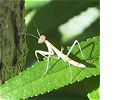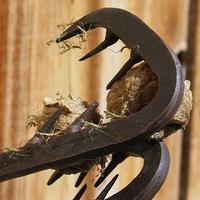In the spring, if you purchase an egg case from our shop, take it home and place it in a sunny location a few inches to a foot or so above the ground, snug in a bush or low branch. Keep an eye on it. If you can catch the moment the nymphs begin to emerge from the case, you will witness an amazing sight. It's lucky for the Mantids, too, since if you catch them hatching, you can gently scatter them around your garden. This can help them survive since they are solitary and need to disperse quickly else they will eat each other. You have to get used to the fact, too, that very few of the nymphs will in fact survive. This is just how it is. Nature is cruel that way. The ones that do survive will delight you and your garden guests.
Typically, you'll pretty much lose track of them in the garden while they're small. You'll see them occasionally and then you'll again lose track. One day you'll notice they've grown. Two inches long, then three, then four. You'll also notice discarded skins occasionally, left behind from molting. Then one day you'll see a full grown adult. The surprise will be a delight, as they are stunningly and strangely beautiful. At that point you'll be able to visit with the Mantis pretty much on a daily basis, as they will find a place where the food is plentiful, and if all is safe enough, they will stay in that one place until mating season.
Mantids are friendly to humans, tolerating us as neither predator or prey. The two garden worlds -- human and mantis -- intertwine quite easily. In fact, the Praying Mantis is usually calm, gentle, unafraid and tolerant toward humans. Because of this, many people attempt to keep them in cages as pets. We recommend thinking of your garden as their home. That way, you can live with them inside their space. They can take care of themselves. Plus, in the garden they can be your Pest Control Workers.
Don't Use Poisons!
For the most part, poisons on your plants isn't a good idea, for poisons tend to be indiscriminate in their killing abilities. They kill the bad and the good insects alike. That means pesticides kill good insects like Honeybees, Ladybugs and Praying Mantises. Even if the label on the spray can targets certain insects, chemical sprays will kill Honeybees, Ladybugs and Mantids. Plus, the killing is, well, creepy, lazy, usually overkill and the residue is, to say the least, smelly and questionable.
If you want these incredible insects to live in your garden, the first rule would be to stop all use of lawn and garden chemicals. This needs to be restated: It's imperative that you restrict the use of chemicals -- especially pesticides -- to an absolute minimum. This might seem like a harsh requirement, but it's absolutely true that the Mantid needs an environment free of deadly pesticides and other harsh lawn and garden chemicals. You'll notice other desirable wildlife will begin to come around, like Hummingbirds and Butterflies.
Our proximity to the Mantid's world opens up for us a glimpse into the macro world of insect and plant life, the world so loved by entomologists and other biologists. But it's also the love of Lewis Carroll, J.R.R. Tolkien, and all the greatest nature writers in the world. All this right in our own back yards. To get there is fairly easy. Simply provide a healthy space, free of chemicals and their worlds will unfold. Let the Ladybugs, the Lacewings and the Praying Mantises be your pest control workers. The balance will allow all those who visit to breath freely. You won't have to worry about poisoning yourself and you'll come to notice the subtle meaning to the phrase, "a living garden , a gardener alive."
The Insect Pet Trade
If you search the web or visit your favorite super pet store you'll find all sorts of peddlers pushing Mantids as cageable pets.If you research the insect pet trade, you will soon come to understand that an insect's prospects for a prolonged, healthy, fulfilling life inside a cage are close to nothing. And since not too many Mantid Nymphs make it to adulthood, it would make sense to allow those that do survive the chance to live undisturbed along side we humans in the garden. Perched in the plants we walk through, they look at us at times in their warm, typical Mantid day.
With the requirements, the warnings and the stories, it is easy to see that Mantids don't want to be in boxes or jars or aquariums. With this in mind, the egg pods we sell are meant to be hatched out of doors in a healthy, living environment, namely your garden. We sell Mantid egg cases hoping that the Mantid Nymphs will grow up and live well in local gardens, and not confined within cages.
Consider the demanding list of activities required for maintaining a healthy environment for a caged Mantis, none of which are required when allowed to live freely out of doors: for example, Petco recommends daily feeding, watering, misting and cleaning routines for the cage, and "at least once a week," pet owners should "...scrub the tank and furnishings with a 3% bleach solution, rinse thoroughly with water, removing all smell of bleach; dry the tank and furnishings; and add clean substrate." Drinking water should be misted and without chlorine. For proper nutrition, their daily food intake should include a wide variety of live flying insects (store bought crickets are not enough).
One web site recommends use of a pair of tiny tools to hold live honeybees in place in order to extract their stingers before feeding them to your Mantis. This is to shield your Mantis from possible stings. Other sites detail the many physical (including sexual) frustrations the Mantis will have to endure in captivity. The Petco Care Sheet also warns against the "Common Health Issues" associated with captivity and gives suggested actions. For dehydration, Petco recommends consulting "your exotic animal veterinarian." For wounds resulting from falls within the cage, Petco suggests coating the wound with "fingernail hardener."
We recommend leaving them in the wilds of your garden. All such concerns are avoided completely by allowing the Mantids to take care of themselves 24/7 outside, in the garden, in a place of their neolithic, ecologically wise choosing, feeding on pests like wasps and flies.
The Praying Mantis is cool. They can catch golf ball sized wasps in mid air. We think they should be left outside in the wild garden where they can live out their short lives on their own. They will be there. They will fend for themselves for the season of their lives. And if they happen to live in your garden, consider yourself extremely lucky. Keep them in mind and they will surely draw you out of the house into their daily world of risk and wonder.
There are over 2000 different types of Mantid, but only three are common in the United States. For our climate, if you see one in your garden, it is most likely a Chinese Praying Mantis. The egg cases we sell are of this variety. This Mantid lives for a single garden growing season, hatching in late spring and lasting until the killing frost. If they happen to mate, the female will deposit any where from 6 to 20 or so egg casings which look like small paper cocoons. She will attach these to stems and branches around the yard. Each case holds up to around 300 eggs. These egg casings will winter over and hatch in late spring. The mom will long be gone. The cycle will have begun anew. In proportion to the number of hatchlings, very few survive each year. The ones that do survive will give you hours of wonder and pleasure. It's always thrilling to have them back.
Determining the Sex of a Praying Mantis
People on the internet who claim to know promote at least two different ways of determining whether your Mantid is a male or a female.
- The female has six plates on her abdomen. The male has eight.
- The male's wings reach to the end of his body. The female's wings are short by a quarter of the length of her body.
These two methods seemed to conflict with our Mantis, Barbarella. She seems to have only six plates, and yet the wings reach to the end of his body. The season is still in swing. As autumn approaches, perhaps we'll come to know.
The Wild World of Your Garden
Introducing Mantids into your garden adds a dimension of wildness that you can watch, study and enjoy. Mantids are wild creatures. They adapt to your garden as to a world of insect dangers and insect delights.
 This Mantid to your left is newborn, about 1/2 inch long. If it survives to adulthood, it will grow to be 4 to 5 inches long. Like a watchdog, the Mantis will grow to territorialize your yard, keeping keen eye out for all the 'insect intruders.'
This Mantid to your left is newborn, about 1/2 inch long. If it survives to adulthood, it will grow to be 4 to 5 inches long. Like a watchdog, the Mantis will grow to territorialize your yard, keeping keen eye out for all the 'insect intruders.'
If a Mantid does take up residency in a potted tree or some other prime spot for laying in wait, prepare yourself. You will become mesmerized. They will grow with your garden and your summer like a wild bird that needs no cage. And when the cold fronts begin to whiten the Sierra ridges, we get a much more intimate understanding of the phrase, "killing frost." But such is the short life of the Mantid. Adults rarely last six months.
Also prepare yourself for injuries, even mortal ones. These seemingly brave creatures will attack stinging prey many times their size. It's a wild world out there in the lovely garden, so look forward to Nature's rough play.



 This Mantid to your left is newborn, about 1/2 inch long. If it survives to adulthood, it will grow to be 4 to 5 inches long. Like a watchdog, the Mantis will grow to territorialize your yard, keeping keen eye out for all the 'insect intruders.'
This Mantid to your left is newborn, about 1/2 inch long. If it survives to adulthood, it will grow to be 4 to 5 inches long. Like a watchdog, the Mantis will grow to territorialize your yard, keeping keen eye out for all the 'insect intruders.'